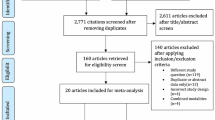Abstract
Background
With the recent, widespread availability of endoscopic hemoclips, it has become common clinical practice to apply hemoclips to some non-bleeding polypectomy sites “prophylactically” to prevent delayed post-polypectomy bleeding (PPB). Few published data support this practice, however.
Aim
The aim of this study was to compare rates of delayed PPB in matched patients who had polypectomies performed with and without the prophylactic placement of hemoclips.
Methods
We reviewed medical records of patients who had elective colonoscopy at our VA Medical Center between July 2008 and December 2009. We identified patients who had hemoclips applied prophylactically (cases) and compared their rate of delayed PPB within 30 days to that of patients who had polypectomy without hemoclipping (controls). Controls were matched 1:1 to cases based on age and on factors known to contribute to the risk of PPB including polyp size, morphology, technique of polyp removal, number of polyps removed, and use of anticoagulants.
Results
We identified 184 patients (cases) who underwent prophylactic hemoclipping and 184 well-matched controls. An average of 3.8 polyps per patient were removed in the case group compared to 3.3 polyps per patient in controls (p = 0.6). Delayed PPB occurred in three patients in the prophylactic hemoclip group and in one patient in the control group (1.6 vs. 0.5 %, p = 0.62).
Conclusions
We found no significant difference in the rate of delayed PPB between patients who had prophylactic hemoclipping of polypectomy sites and a well-matched control group of patients who had polypectomy without prophylactic hemoclipping. These data call into question the expensive practice of prophylactic hemoclipping.

Similar content being viewed by others
References
Kapetanos D, Beltsis A, et al. Postpolypectomy bleeding: incidence, risk factors, prevention and management. Surg Laparosc Endosc Percutan Tech. 2012;22:102–107.
Fatima H, Rex D. Minimizing endoscopic complications: colonoscopic polypectomy. Gastrointest Endosc Clin N Am. 2007;17:145–156.
Shioji K, Suzuki Y, et al. Prophylactic clip application does not decrease delayed bleeding after colonoscopic polypectomy. Gastrointest Endosc. 2003;57:691–694.
Quintanilla E, Castro JL, Rábago LR, et al. Is the use of prophylactic hemoclips in the endoscopic resection of large pedunculated polyps useful? A prospective and randomized study. J Interv Gastroenterol. 2012;2:183–188.
Watabe H, Yamaji Y, et al. Risk assessment for delayed hemorrhagic complication of colonic polypectomy: polyp related factors and patient related factors. Gastrointest Endosc. 2006;64:73–78.
Liaquat H, Rohn E, Rex DK. Prophylactic clip closure reduced the risk of delayed postpolypectomy hemorrhage: experience in 277 clipped large sessile or flat colorectal lesions and 247control lesions. Gastrointest Endosc. 2013;77:401–407.
Edmundowicz SA. To clip or not clip: is that the question? Gastrointest Endosc. 2013;77:408–409.
Kaltenbach T, Soetikno R. Endoscopic resection of large colon polyps. Gastrointest Endosc Clin N Am. 2013;23:137–152.
Feagins LA, Uddin F, et al. The rate of post-polypectomy bleeding for patients on uninterrupted clopidogrel therapy during elective colonoscopy is acceptably low. Dig Dis Sci. 2011;56:2631–2638.
Feagins LA, Iqbal R, Harford W, et al. Low rate of post-polypectomy bleeding among patients who continue thienopyridine therapy during colonoscopy. Clin Gastroenterol Hepatol. 2013;11:1325–1332.
Hui A, Wong R, et al. Risk of colonoscopic polypectomy bleeding with anticoagulants and antiplatelet agents: analysis of 1357 cases. Gastrointest Endosc. 2004;59:44–48.
Friedland S, Sedehi D, Soetikno R. Colonoscopic polypectomy in anticoagulated patients. World J Gastroenterol. 2009;15:1973–1976.
Parikh N, Zanocco K, Keswani RN, Gawron AJ. A cost efficacy decision analysis of prophylactic clip placement after endoscopic removal of large polyps. Clin Gastroenterol Hepatol. 2013;11:1319–1324.
Acknowledgments
This work was supported by the Office of Medical Research, Department of Veteran’s Affairs.
Conflict of interest
Dr. Feagins has received research funding from Altheus Therapeutics for an unrelated project. Dr. Spechler is a consultant for Torax Medical Inc., Ironwood Pharmaceuticals Inc., and Takeda Pharmaceuticals Inc.; however, none of these are relevant to this article. A.D.N. and R.I. have nothing to disclose.
Author information
Authors and Affiliations
Corresponding author
Rights and permissions
About this article
Cite this article
Feagins, L.A., Nguyen, A.D., Iqbal, R. et al. The Prophylactic Placement of Hemoclips to Prevent Delayed Post-polypectomy Bleeding: An Unnecessary Practice? A Case Control Study. Dig Dis Sci 59, 823–828 (2014). https://doi.org/10.1007/s10620-014-3055-0
Received:
Accepted:
Published:
Issue Date:
DOI: https://doi.org/10.1007/s10620-014-3055-0




